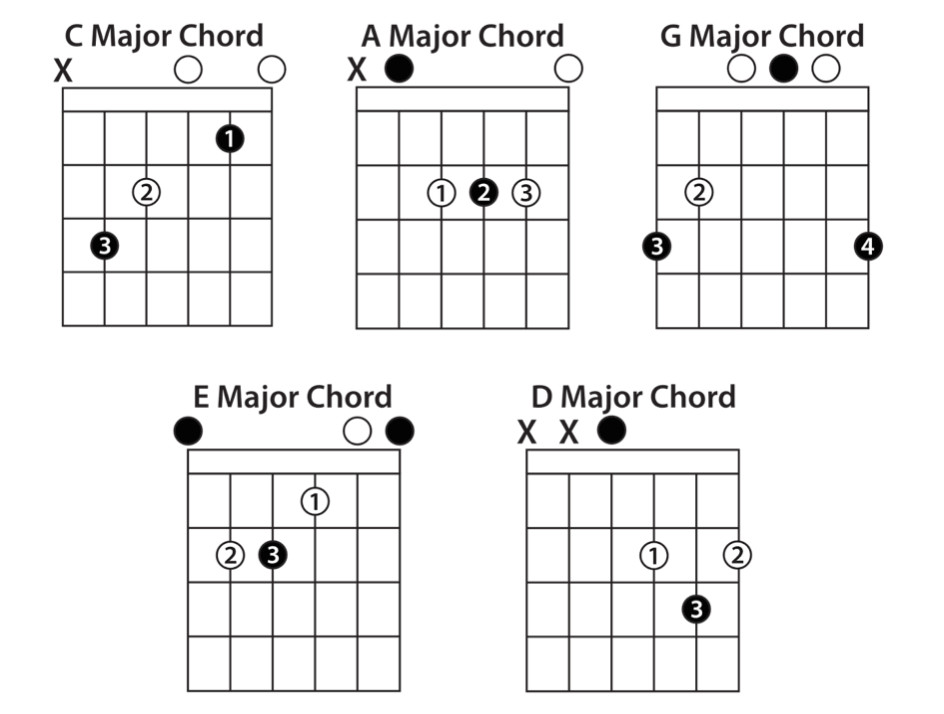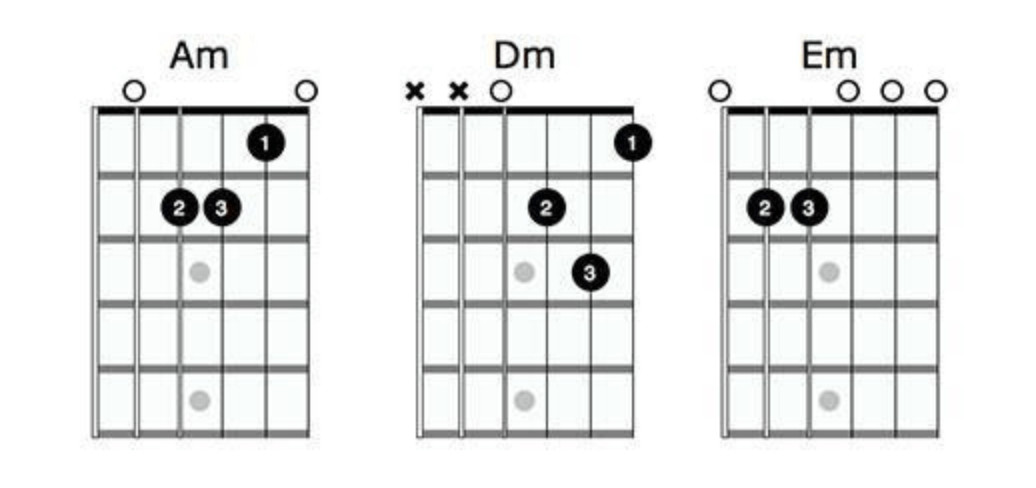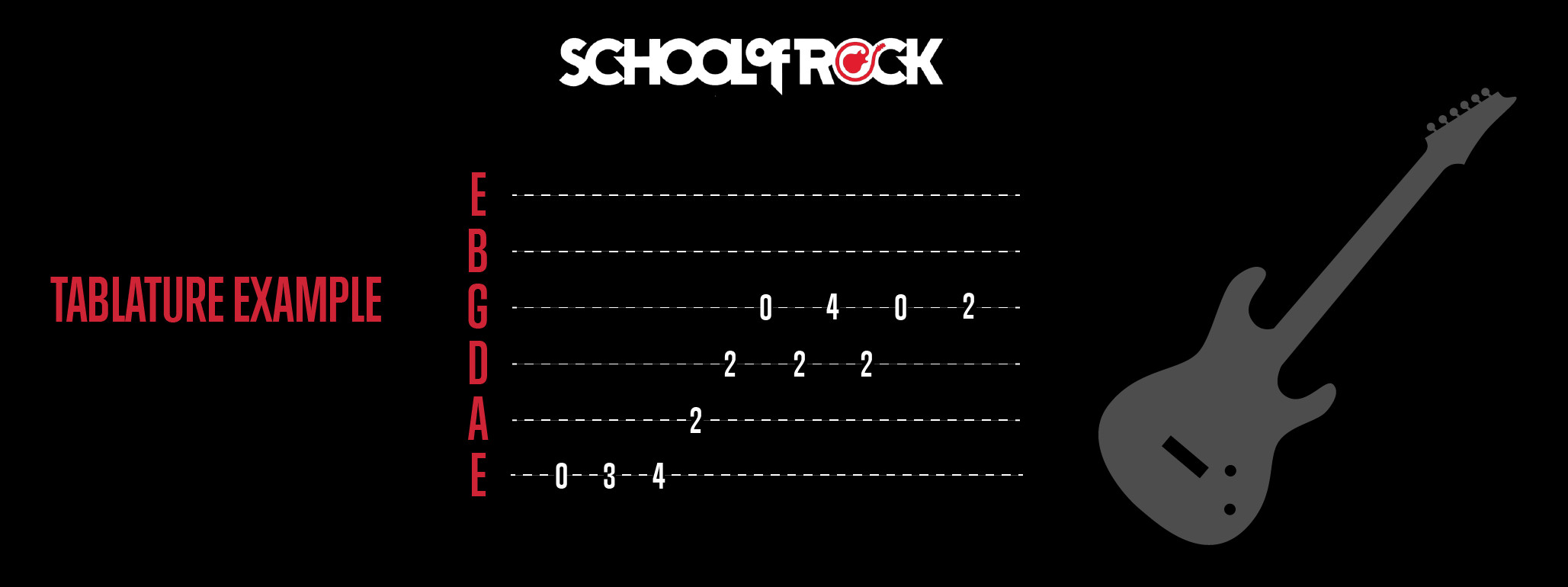Picking up a guitar for the first time is exciting, but the initial question often is: “What do I play?”. For most guitarists, learning chords is the fundamental starting point. Chords are the building blocks of harmony in music. They provide rhythm and depth, making music feel complete. While instruments like drums and bass focus on rhythm and depth, guitars (and many others) bring harmony through chords. Let’s explore simple guitar chords perfect for beginners, get some helpful tips on playing them, and discover songs you can start learning right away.
The School of Rock method emphasizes practical application, encouraging students to take their lesson room knowledge to the stage. Students learn to play as lead or rhythm guitarists. Lead guitarists typically focus on melodies, riffs, and solos, while rhythm guitarists are the chord masters, utilizing strumming and fingerpicking techniques. Regardless of your preferred style, mastering chords is essential. If you’re considering buying your first guitar or upgrading, our guitar-buying guide offers valuable advice.
Understanding Basic Guitar Chords
Learning chords can seem daunting initially because of the different types and ways to play them. However, there are three main types of chords that are foundational for guitarists.
Power Chords: The Rock and Roll Starting Point
Power chords are often among the first chords taught at School of Rock, and for good reason. They are incredibly versatile, used across genres from rock to pop. Power chords are beginner-friendly because they typically involve only two or three strings and frets, making them easier on your fingers. While playable on any guitar, they are particularly prominent on electric guitars. When played on an electric guitar, power chords can be easily distorted, adding a powerful edge and mood to your music.
Open Chords: The Foundation of Strumming
Open chords are another excellent choice for beginners. As the name suggests, they incorporate open strings, meaning some strings are played without being fretted. Similar to power chords, open chords often use fewer frets and fingers, simplifying the playing process. The key difference is that open chords utilize all six strings of the guitar. Your fretting hand won’t be needed for every string, making them comfortable to learn. A common set of open chords is often referred to as CAGED chords, which we’ll explore in more detail shortly.
Barre Chords: Stepping Up Your Chord Game
Barre chords are more advanced compared to power and open chords and can be trickier to master initially. However, they are incredibly useful as you progress. Once you understand the shape of a barre chord, you can move that same shape up and down the guitar neck to create a wide range of chords. This means you can switch between barre chords efficiently by simply sliding your hand, rather than completely changing finger positions. The challenge for beginners lies in needing one or sometimes two fingers to press down multiple strings at the same fret simultaneously. We’ll delve into barre chords in more detail another time, but for now, focus on open and power chords.
Mastering Open Guitar Chords for Beginners
Before diving into specific open chords, it’s crucial to ensure your guitar is properly tuned. Playing in tune is essential for your chords to sound correct and musical. If you’re struggling with tuning, School of Rock provides a helpful guide: Beginner’s Guide to Tuning a Guitar.
 Diagram of common open guitar chords for beginners
Diagram of common open guitar chords for beginners
Alt text: Easy to read chord diagram for beginner guitarists showing finger positions for C, A, G, E, D open chords.
Let’s explore open chords, particularly the CAGED system. CAGED is a fundamental concept in the School of Rock method because these chords are used in a vast number of popular songs that students learn and perform. Each letter in CAGED represents a major open chord: C, A, G, E, and D. The diagrams below illustrate how to play each of these chords.
Understanding Chord Diagrams
Chord diagrams are visual representations that show you exactly how to play a chord. They indicate which strings to play, which frets to use, and which fingers to place on those frets. Chord diagrams are read horizontally. The top line represents the thickest string, the low E string, and the bottom line is the thinnest, high E string (imagine holding your guitar upright in front of you).
- An “x” above a string indicates a muted string, meaning it should not be played.
- An “o” or circle above a string signifies an open string, played without any finger on the fretboard.
- Numbers on the diagram indicate which finger to use: 1 (index finger), 2 (middle finger), 3 (ring finger), and 4 (pinky finger).
- The vertical boxes represent the frets. The topmost box is the first fret, the next box is the second fret, and so on.
For example, in the A major chord diagram, the numbers are all on the second fret box. This means you’ll be playing notes on the second fret. Specifically, your index finger goes on the second fret of the D string, your middle finger on the second fret of the G string, and your ring finger on the second fret of the B string.
 Chord diagram for C, A, G, E, D open chords with finger positions indicated
Chord diagram for C, A, G, E, D open chords with finger positions indicated
Alt text: Detailed chord diagrams for beginner guitar chords C Major, A Major, G Major, E Major, and D Major, clearly showing finger placements for each chord.
In addition to the CAGED chords, here are a few more essential and easy-to-learn open chords for beginners.
 Diagram showing additional simple open guitar chords: Em, Dm, Am
Diagram showing additional simple open guitar chords: Em, Dm, Am
Alt text: Further beginner guitar chord diagrams illustrating finger positions for E minor (Em), D minor (Dm), and A minor (Am) chords.
It’s important not to confuse chord diagrams with tablature (TAB). Tablature is another system used to read guitar music, but it represents music in a different way. In tablature, the lines are read vertically, and they represent the guitar strings. The bottom line is the low E string, and the top line is the high E string. Numbers on the lines in tablature indicate the fret number to play on that string. “0” represents an open string.
 Example of guitar tablature notation
Example of guitar tablature notation
Alt text: Example of guitar tablature showing numbers on lines representing frets and strings for guitar music notation.
Chord diagrams are incredibly helpful for learning chords because they visually guide you on finger placement and correct finger usage for smooth chord transitions. With practice, these shapes will become muscle memory, and you’ll be able to play chords without constantly looking at diagrams.
Essential Tips for Playing Simple Guitar Chords
As you learn these and other new chords, keep these essential tips in mind:
- Fret Close to the Fret Wire: On a guitar, frets are separated by thin metal bars called fret wires. Position your fingers just behind these wires, closer to the bridge of the guitar. This requires less pressure and produces a clearer sound. Experiment with placing your finger just behind the fret, in the middle of the fret space, or between the two fret wires to find what works best for you.
- Use Your Fingertips: Press down on the strings with the very tips of your fingers. This provides the cleanest sound. Keep your fingers arched, like a “C” shape, to avoid accidentally touching or muting adjacent strings, ensuring each note rings clearly.
- Play Each String Individually: If a chord sounds muddy or incorrect, strum each string of the chord one at a time. This helps you identify if a specific string isn’t ringing clearly. If you find a muted string, adjust your finger position until all notes in the chord sound clear.
- Practice Fretting and Unfretting: Practice transitioning into and out of chord shapes. Lift your fingers off the fretboard and then quickly place them back down into the chord shape. You can also practice hovering your fingers just above the fretboard in the correct chord shape, helping build muscle memory for quick and accurate chord changes.
Songs to Play with Simple Guitar Chords
Now that you have some basic guitar chords under your fingers, let’s explore some popular songs you can play using these chords. Many well-known songs are based on simple chord progressions, making them excellent practice material for beginners. The CAGED chords and basic minor chords open up a wide range of songs, including:
- Sweet Home Alabama by Lynyrd Skynyrd: A classic beginner song using only three chords: C, G, and D.
- Bad Moon Rising by Creedence Clearwater Revival: In the key of D, this song uses G, D, and A chords.
- Love Me Do by The Beatles: In the key of G, using G, C, and D chords.
- Eleanor Rigby by The Beatles: In E minor, this song primarily uses C and variations of Em chords.
- Time Of Your Life by Green Day: In G major, using G, C, Cadd9, and D5 power chords. You can simplify the D5 power chord to a regular D major chord for easier playing.
- Island in the Sun by Weezer: Features a four-chord progression throughout most of the song: Em, Am, D, and G. The bridge section uses power chords, offering a chance to practice both open and power chords.
- Boulevard of Broken Dreams by Green Day: In F minor, using Em, G, D, and A chords. Power chords are also used towards the end, again providing practice for both open and power chord styles.
More Popular Songs for Beginner Guitarists:
- Hey There Delilah by Plain White T’s
- Hallelujah by Leonard Cohen
- Redemption Song by Bob Marley
- Smoke on the Water by Deep Purple
- Stairway to Heaven by Led Zeppelin
- Hotel California by Eagles
Exploring Power Chords Further
Power chords are often considered easier than open chords but share similarities with barre chords. Let’s break down why. Compared to open chords, power chords have fewer notes, meaning they use fewer frets and strings, simplifying finger positions. However, the underlying chord shapes have resemblances.
Consider an A major chord and an A5 power chord. An A major chord contains the notes A, C#, and E. An A5 power chord consists of A and E. The A major chord focuses on the root, third, and fifth intervals, while the A5 power chord emphasizes the root, fifth, and octave (which is the same note as the root, but an octave higher). Essentially, they are closely related, with the power chord omitting the third interval.
This missing third is significant because the third interval determines whether a chord is major or minor. Since power chords lack a third, they are neither major nor minor. This neutrality makes them versatile; they can be used in place of either major or minor chords in many musical contexts. Experiment and listen to the difference between open chords and power chords to develop your ear.
Power chords also share a technique with barre chords. Three-string power chords can be played using a “barre” technique, where one finger presses down two strings at the same fret. This is excellent practice for developing the finger strength and technique needed for full barre chords, allowing you to start with barring just two strings and gradually work up to barring all six.
Power chords are prevalent in classic rock and modern pop music. School of Rock’s Rock 101 program introduces beginner guitarists to power chords within this musical style. Here are some songs that utilize power chords and are great for practice:
- Wild Thing by The Troggs: Focuses on A5, D5, and E5 power chords, with occasional G5 power chords.
- Let It Be by The Beatles: Playable with either open chords or power chords. The original uses C, G, Am, and F open chords. You can substitute with C5, G5, and F5 power chords for a rock-oriented feel.
- Rock and Roll by Led Zeppelin: Relies heavily on A5, D5, and E5 power chords.
- I Love Rock and Roll by Joan Jett: Uses E5, A5, and B5 power chords.
- When I Come Around by Green Day: Entire song based on power chords: F#5, C#5, D#5, and B5.
- Rockin’ In the Free World by Neil Young: Starts with power chords (E5, D5, C5) and transitions into a mix of power and open chords (Em, D, C).
 Diagram showing common power chords for beginner guitarists
Diagram showing common power chords for beginner guitarists
Alt text: Chord diagrams illustrating common power chords for beginner guitar players, including A5, C5, D5, E5, G5.
Ready to Learn More?
Now that you’ve explored simple guitar chords and some songs to play, are you ready to put your knowledge into practice? Do you feel you need further guidance? School of Rock is here to help! We offer private music lessons and various music programs designed to get you started on the right path. Programs like Rock 101 and the Performance program are specifically designed to help beginners and intermediate players apply their private lesson skills to learning and performing full songs in a band setting. Through these programs and lessons, students not only develop musical talent but also gain valuable life skills like teamwork and build confidence through performance experience. Many of the songs mentioned in this article are part of these programs, helping students master open guitar chords, power chords, and learn fundamental music theory. If you’re interested in taking your guitar playing to the next level, contact your nearest School of Rock location to learn more.
About the Author:
Miranda Morales is a guitar and keyboard instructor at School of Rock Easton in Pennsylvania.
